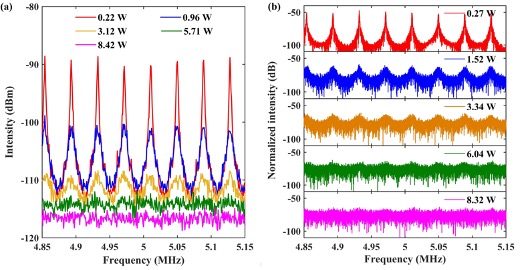A laser typically comprises three essential components: a pump source, a gain medium, and a resonator. Due to the selective effect of the resonator architecture on the lasing frequency, the multi-longitudinal mode operation is one of the natures of fiber lasers with conventional resonant cavity structure, which manifests as periodic beating peaks in the radio frequency (RF) spectrum and periodic fluctuations in time domain. However, the discrete longitudinal mode distribution may pose problems for some applications based on lasers as light sources. For high-resolution laser-based optical sensor systems, for example, the single-mode signal peaks obtained by sensing elements such as phase-shift gratings can only jump between discrete longitudinal modes when drifting with the sensing parameters, and continuous frequency shift cannot be achieved. Therefore, discrete longitudinal modes limit the maximum resolution of such optical sensors.
Recently, a team led by Professor Xuewen Shu at Huazhong University of Science and Technology in China has proposed a modeless Raman fiber laser (RFL). The laser adopts a conventional resonator structure, but the output cavity mirror is an ultralow reflectivity fiber Bragg grating (FBG). Due to the modulation instability, with the increase of the Stokes wave power, the longitudinal modes in the cavity gradually broaden, and finally the adjacent longitudinal modes overlap. In this case, the RFL has a quasi-continuous spectrum without discrete longitudinal modes, and laser operates at a modeless state. The related work, titled Modeless Raman Fiber Laser, was published on July 31st in the journal Optica.
The proposed modeless RFL is schematically depicted in Fig. 1. In order to avoid the relative intensity noise transmission from the pump source to the Raman laser, the pump source employs an ASE source constructed by the researchers themselves. The output cavity mirror uses an FBG with an ultralow reflectance of -27 dB.

Fig. 1. Experimental setup of the modeless RFL.
The state of the longitudinal modes can be obtained from RF spectrum. The RF spectra of the RFL are experimentally measured at various laser output powers, as shown in Fig. 2(a). At low power levels, there are significant characteristic peaks in the RF spectrum. However, with the increase of Stokes wave power, the periodic beating peaks corresponding to cavity length gradually broadens and the peak height decreases. When the output power reaches 5.71 W, there is no resolved beating peak in the RF spectrum. This means that the discrete multi-longitudinal modes of the RFL will gradually broaden as the power increases and eventually fully overlap. In this case, the RFL no longer has discrete longitudinal modes like a conventional laser but generates a quasi-continuous spectrum similar to that of an ASE source.
The researchers use the generalized nonlinear Schrödinger equation to simulate the evolution of laser field in the RFL, and the RF spectra obtained are shown in Fig. 2(b). The simulation results show that the periodic beating peaks gradually disappears with the increase of power.

Fig. 2. Evolution of the RF spectra with laser output power. (a) Experimental measurement; (b) Simulation results.
Benefiting from the quasi-continuous spectrum, modeless RFLs can be used for high-resolution sensing. What’s more, the disappearance of the RF peak means that the laser radiation no longer has the temporal periodicity corresponding to the length of the resonantor. So modeless RFLs are also expected to be ushered as ideal light sources into secure communication, fast physical random bit generation and time-domain ghost imaging.
Paper Link: https://doi.org/10.1364/OPTICA.488920